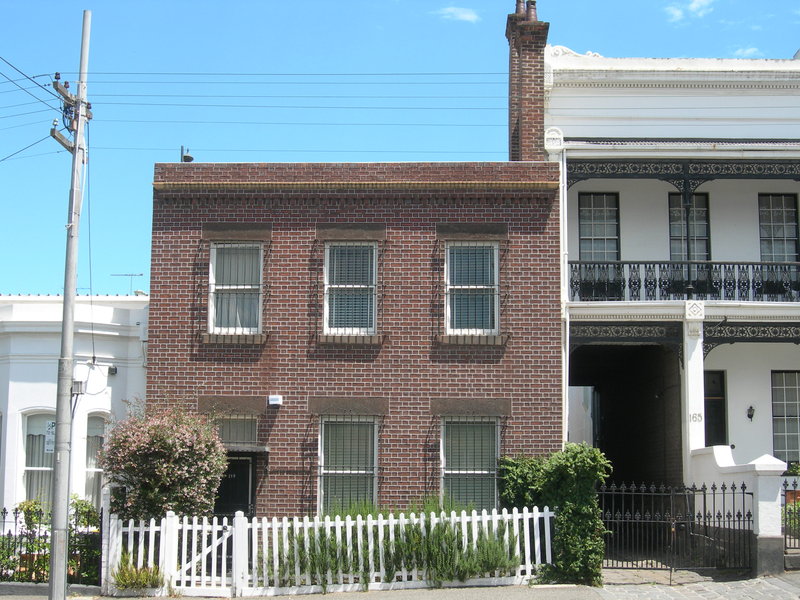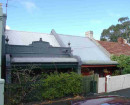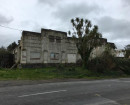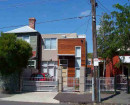LITTLE PARNDON
159 GIPPS STREET EAST MELBOURNE, MELBOURNE CITY
-
Add to tour
You must log in to do that.
-
Share
-
Shortlist place
You must log in to do that.
- Download report






Statement of Significance
What is significant?
Little Parndon is a two storey brick house built by Ravenscroft and Oldfield in 1862 for the Austrian painter Eugene von Guerard. A rear extension was added in 1866. It is in a simple Georgianesque style with plain openings, a plain parapet and no verandah. Embellishment is restricted to stone sills and lintels and a simple brick cornice. The grilles over the windows and the picket fence are not contemporary to the construction of the house. Internally the original 1862 structure comprises an entry hall, four main rooms, two to each storey and upstairs bathroom. The ground floor rooms comprises a drawing room divided by bi-fold doors. There is a white marble fireplace to each section, probably dating from the early twentieth century. Stairs lead up from the main passageway to the two first storey bedrooms and a small bathroom. The bedrooms have built-in cupboards, possibly dating from sometime before the Second World War, and timber fireplaces. The 1866 extension comprises a three storey addition including a tower room. The extension consists of a ground floor vestibule, a kitchen, a first storey bedroom and tower room bedroom. The double-L stair rises to the tower room, which is square in plan with windows to all sides. The general decorative scheme is c1950, from the period of occupation by Lord and Lady Casey who lived at Little Parndon from 1949.
How is it significant?
Little Parndon is of architectural, aesthetic and historical significance to the State of Victoria.
Why is it significant?
Little Parndon is architecturally significant as a fine example of an early Melbourne town house in the English manner. It is characterised by stylistic restraint, graceful proportions and the unusual absence of a verandah. The face red tuck-pointed brickwork and simple brick cornice add considerable elegance to the main facade. The house is highly unusual for its plain face red brickwork that predates the fashion for polychrome work and marks the house as stylistically idiosyncratic in East Melbourne.
Little Parndon is aesthetically significant for its intact internal decorative scheme of c1950. The decoration reflects the personal tastes of Lord and Lady Casey. It is unusual for a building of this age to demonstrate a period and style of extant decoration that is consistent throughout the house.
Little Parndon is historically significant for its association with the migrant Austrian painter Eugene von Gerard. Gerard emigrated to Australia as a painter and teacher and was influential in the early development of Australian romantic landscape painting. In 1870, during his occupation of Little Parndon, he was appointed first Master of Painting at the National Gallery School, Melbourne, and was made curator of the National Gallery of Victoria.
Little Parndon has additional historical significance for its associations with Lord and Lady Casey who occupied Little Parndon from 1949 to the early 1980s. Lord Casey was Governor General of Australia from 1965 to 1969. Lady Casey, an artist in her own right, was instrumental in the formation of the conservation movement in Melbourne during the 1950s. Maie Casey was co-editor of "Early Melbourne Architecture" in 1953, a book that helped raise awareness about the need for the conservation of the built environment in Melbourne.
-
-
LITTLE PARNDON - History
Contextual History:
A notice of intent to build a residence for Eugene von Guerard was registered by the builders Ravenscroft and Oldfield on 2 January 1862. No architect was named. The original house comprised a simple two storey brick structure with four main rooms, two to each storey.
A further notice of intent to build was lodged four years later in April 1866 by builder James Dickson. The three storey addition at the rear of the house is clearly recognisable as a later structure because of the awkward junction with the main carcass of the house visible in the stairwell leading to the tower room. The downstairs powder room and toilet area may have replaced an earlier W.C.
Eugene von Guerard occupied Little Parndon until 1882. During the interwar period it operated as a boarding house (Casey, W J Hudson 1986).
The house was bought by RG Casey (later Lord Casey) and his wife Maie in 1939, but it was not until some time after the war that they were able to spend much time there. Their time was split between Little Parndon and thier house at Berwick. The decorative scheme of the house still reflects their period of the Caseys occupancy. The wallpaper was from New York (Casey, W J Hudson 1986. Maie Casey died in 1983 and the property was passed into a trust.
Eugene von Guerard was born in Austria in 1811, worked in Australia 1852-1882, (he arrived in Melbourne in 1854) and died Great Britain 1901.
As a youth, von Guerard travelled to Italy with his father, who was a painter of miniatures. In Rome and Naples the young von Guerard began his artistic training. From c. 1839 to 1844 he studied landscape painting at the Düsseldorf Academy, Germany.
On von Guerard's arrival in Victoria he immediately set off to Ballarat in search of gold, but after sixteen months he had little success. He then settled in Melbourne and by the 1860s was considered Victoria's foremost landscape artist. He remained in Australia for nearly thirty years and during this time undertook many remarkable sketching tours of most of south-eastern Australia as well as New Zealand.
In October 1862 von Guerard began a tour of the north-eastern district of Victoria and Mount Kosciusko with Professor Georg von Neumayer, who was conducting a magnetic survey for the Victorian colonial government. The painting Mount Kosciusko seen from the Victorian border (Mount Hope Ranges) 1866, completed in 1866, was inspired by this tour.
Wealthy patrons keen to impress their refinement were attracted to the detail, scale and grandeur depicted in the works of von Guerard. Numerous commissions followed and the artist's popularity in the 1860s resulted in his appointment in 1870 as the first director of the Melbourne National Gallery and School of Art.
(National Gallery of Victoria education notes)
Lord Casey was a Governor General of Australia and the only Australian to be a member of the Imperial War Cabinet during World War II. Between 1940 and 1942 he was the Australian Minister to the USA, head of Australia's first diplomatic post abroad.
Lady Casey was a co-editor of the influential book Early Melbourne Architecture 1840-1888 first published in 1853. This book was indicative of a raised awareness of the nineteenth century built heritage of Melbourne in the years leading up to the establishment of the National Trust in Victoria in 1956.
Associated People: Eugen von Guerard
Von Guerard was a Viennese who arrived in Victoria in 1852 as a gold digger. He was not successful at gold digging but brought instead a series of pencil sketches. He was particularly interested in painting the scenery of Australia and New Zealand, but his early paintings brought little return. The Argus newspaper reported him raffling tickets for pictures he was displaying at the Mechanics’ Institute. Despite the Argus newspaper praising his work, only 100 of the 150 tickets were sold. [Winston Burchett, East Melbourne 1837-1977, Melbourne 1977, p.117] In 1870 he became a charter member of the Victorian Academy of Arts and was awarded the Cross of the Order of Franz Joseph by the Austrian Emperor. In the same year he was appointed first Master of Painting at the National Gallery School, Melbourne, and was made curator of the National Gallery of Victoria. Von Guerard lived in Little Parndon for twenty years after it was built in 1862. He died in 1901.
Lord and Lady Casey
Richard Gardiner Casey was born in Brisbane in 1890. He entered Trinity College at the University of Melbourne in 1910 but moved to Trinity College Cambridge, graduating in 1913. During the First World War he served at Gallipoli and in France, achieving the rank of Major. In 1931 he entered Federal parliament as United Australia Party member for Corio. After the death in 1939 of Prime Minister JA Lyons he sought the vacant position but lost to Menzies. In 1940 he went to Washington to open Australia’s first diplomatic legation in the United Sates, and in 1942 crossed the Atlantic to serve in the War Cabinet as Minister of State for the Middle East. Between 1944 and 1946 he was Governor of Bengal. When Casey returned to Australia after the war he was for a time Federal President of the Liberal Party, and then between 1951 and 1960 Minister for External Affairs. He retired in 1960 and was made a Life Peer. He returned to public life to be Governor-General of Australia between 1965-69. Lord Casey died in 1976. [Australians, A Historical Dictionary, 1987, pp.68-69]
Ethel Marian Sumner (Maie) Casey was born in Melbourne and educated in England. Her art and paintings were exhibited in New York in 1941 and 1958. She was an honorary member of the International Council of the Museum of Modern Art in New York. [F Johns, Who’s Who in Australia, p.244] In 1953 Maie Casey was a joint editor of Early Melbourne Architecture 1840-1888. This book was a part of the movement in Melbourne to form a conservation group, which was to finally emerge in 1956 as the National Trust of Australia (Victoria). The book concentrated primarily on institutional architecture and the houses of the wealthy in East Melbourne, Toorak and South Yarra. Stylistically it illustrated the Georgianesque and classical revival styles in preference to the Gothic. Lady Casey died in 1983.LITTLE PARNDON - Assessment Against Criteria
a. The historical importance, association with or relationship to Victoria's history of the place or object
b. The importance of a place or object in demonstrating rarity or uniqueness
c. The place or object's potential to educate, illustrate or provide further scientific investigation in relation to Victoria's cultural heritage
d. The importance of a place or object in exhibiting the principal characteristics or the representative nature of a place or object as part of a class or type of places or objects
Little Parndon is significant for its intact and representational decorative scheme of c1950. Contributory elements include wallpapers and floor tiles. The interior decoration is consistent throughout the house.
e. The importance of the place or object in exhibiting good design or aesthetic characteristics and/or in exhibiting a richness, diversity or unusual integration of features
Little Parndon demonstrates a simple but dignified style of architecture of the early 1860s. The plain red tuck-pointed brickwork is an unusual survivor of non-stuccoed, pre-polychrome work. Little Parndon does not have a verandah which is unusual a house in East Melbourne of this period.
f. The importance of the place or object in demonstrating or being associated with scientific or technical innovations or achievements
g. The importance of the place or object in demonstrating social or cultural associations
Little Parndon has a 20 year association with Eugene von Guerard, one of the leading romantic artists in Australia during the nineteenth century. He was prominent in the formation of the Victorian Academy of Fine Arts and in 1870 was appointed first master of painting at the National School of Art, Melbourne and curator of the National Gallery of Victoria.
Little Parndon was the home of Lord and Lady Casey from 1949 until the death of Maie Casey in the early 1980s. During the period of the Caseys' occupation of Little Parndon, Richard Casey was Minister for External Affairs from 1951 to 1960 and was Governor-General of Australia from 1965 to 1969. Lady Casey was instrumental in the growth of the 1950s conservation movement in Melbourne.
LITTLE PARNDON - Permit Exemptions
General Exemptions:General exemptions apply to all places and objects included in the Victorian Heritage Register (VHR). General exemptions have been designed to allow everyday activities, maintenance and changes to your property, which don’t harm its cultural heritage significance, to proceed without the need to obtain approvals under the Heritage Act 2017.Places of worship: In some circumstances, you can alter a place of worship to accommodate religious practices without a permit, but you must notify the Executive Director of Heritage Victoria before you start the works or activities at least 20 business days before the works or activities are to commence.Subdivision/consolidation: Permit exemptions exist for some subdivisions and consolidations. If the subdivision or consolidation is in accordance with a planning permit granted under Part 4 of the Planning and Environment Act 1987 and the application for the planning permit was referred to the Executive Director of Heritage Victoria as a determining referral authority, a permit is not required.Specific exemptions may also apply to your registered place or object. If applicable, these are listed below. Specific exemptions are tailored to the conservation and management needs of an individual registered place or object and set out works and activities that are exempt from the requirements of a permit. Specific exemptions prevail if they conflict with general exemptions. Find out more about heritage permit exemptions here.Specific Exemptions:General Conditions:
1. All exempted alterations are to be planned and carried out in a manner which prevents damage to the fabric of the registered place or object.
2. Should it become apparent during further inspection or the carrying out of alterations that original or previously hidden or inaccessible details of the place or object are revealed which relate to the significance of the place or object, then the exemption covering such alteration shall cease and the Executive Director shall be notified as soon as possible.
3. If there is a conservation policy and plan approved by the Executive Director, all works shall be in accordance with it.
4. Nothing in this declaration prevents the Executive Director from amending or rescinding all or any of the permit exemptions.
Nothing in this declaration exempts owners or their agents from the responsibility to seek relevant planning or building permits from the responsible authority where applicable.
Exterior
* Minor repairs and maintenance which replace like with like.
* Removal of extraneous items such as air conditioners, pipe work, ducting, wiring, signage, antennae, aerials etc, and making good.
* Installation or repair of damp-proofing by either injection method where the wall is externally plastered or grouted pocket method where there is face brickwork.
Interior
* Refurbishment of bathrooms, toilets and or en suites including removal, installation or replacement of sanitary fixtures and associated piping, mirrors, wall and floor coverings.
* Installation, removal or replacement of kitchen benches and fixtures including sinks, stoves, ovens, refrigerators, dishwashers etc and associated plumbing and wiring.
* Installation, removal or replacement of electrical wiring provided that all new wiring is fully concealed and any original light switches, pull cords, push buttons or power outlets are retained in-situ. Note: if wiring original to the place was carried in timber conduits then the conduits should remain in-situ.
* Installation, removal or replacement of bulk insulation in the roof space.
* Installation, removal or replacement of smoke detectors.
* Installation, removal or replacement of security locks to doors and windows.LITTLE PARNDON - Permit Exemption Policy
The purpose of the permit exemptions is to allow works that do not impact on the significance of the place to take place without the need for a permit. In terms of layout Little Parndon is a highly intact early 1860s house, with very little structural alteration since the rear addition of 1866. The bathrooms have already been modernised. The hierarchy of the original internal space is unchanged. Structural internal alterations, including changes to walls, ceilings, openings and fireplaces will require a permit. Internally the decorative scheme – paint finishes and wallpapers from c1950 – date from the early days of the Caseys’ occupation and, unusually for a house of this age, present a unified scheme of one period. It is desirable to retain the existing internal scheme as far as possible. Internal painting, wallpapering and decorating will require a permit. It is acknowledged that the kitchen may require updating and permit exemptions are given below. The two storey self-contained flat at the rear of the house does not form part of the registration, except for the land. The date of the timber picket fence at the front of the house is not known but its construction is compatible with the absence of cast iron elsewhere on the house.
-
-
-
-
-
PART OF FORMER FOY AND GIBSON COMPLEX
 Victorian Heritage Register H0896
Victorian Heritage Register H0896 -
GRACE DARLING HOTEL
 Victorian Heritage Register H0660
Victorian Heritage Register H0660 -
FORMER YORKSHIRE BREWERY
 Victorian Heritage Register H0807
Victorian Heritage Register H0807
-
'CARINYA' LADSONS STORE
 Victorian Heritage Register H0568
Victorian Heritage Register H0568 -
1 Alexander Street
 Yarra City
Yarra City -
1 Botherambo Street
 Yarra City
Yarra City
-
-












